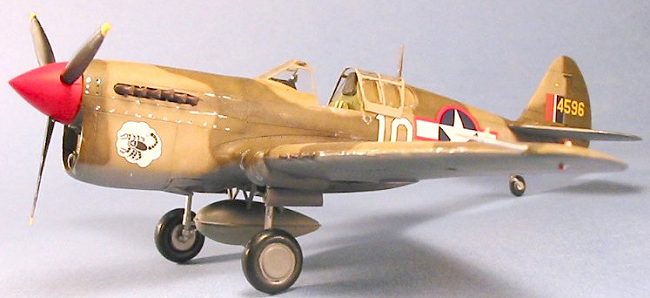
|
KIT: |
AMtech 1/48 P-40F/L Warhawk |
|
KIT # |
? |
|
PRICE: |
$? |
|
DECALS: |
Three Aircraft |
|
REVIEWER: |
|
|
NOTES: |
Pre-production test
shot. Cutting Edge resin cockpit used. |

|
HISTORY |
The P-40 was always at a disadvantage due to the altitude performance restrictions of the non-supercharged Allison engine. In 1941, as Packard began producing the Merlin 28 with a single-stage supercharger, Curtiss decided to change power plants from the Allison to the Merlin. The result was the P-40F and P-40L.
The main visual difference between these two sub-types and others was the lack of the carburetor intake on the upper cowling, and an overall more "squarish" look to the cowl. The P-40F-1 was produced with the short fuselage, which was changed from the P-40F-5 onwards to the extended fuselage which was designed to deal with a lack of directional stability associated with the shorter fuselage.
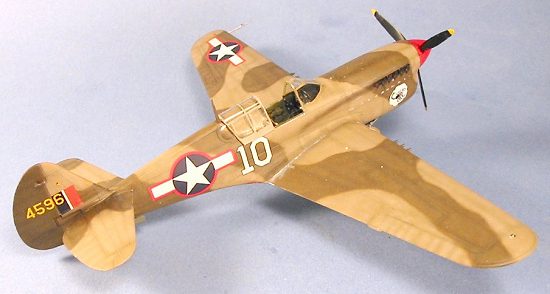 The P-40F entered
production just prior to the attack on Pearl Harbor. The 57th Fighter Group -
equipped with "short-tail" P-40F-1s - was sent to Egypt in the Summer of 1942 to
reinforce the RAF and allow the American pilots to gain valuable combat
experience. Operationally, it was found that the single-stage supercharger did
not provide the P-40F with a major increase in high-altitude performance, though
best altitude was increased from 10,000 ft to 15,000 ft. Given the altitudes at
which combat took place in North Africa, the airplane was not at a disadvantage
so long as there were Spitfire escorts around. Otherwise, the P-40F pilots -
like their Commonwealth counterparts in Allison-powered P-40s - invariably found
the enemy above them.
The P-40F entered
production just prior to the attack on Pearl Harbor. The 57th Fighter Group -
equipped with "short-tail" P-40F-1s - was sent to Egypt in the Summer of 1942 to
reinforce the RAF and allow the American pilots to gain valuable combat
experience. Operationally, it was found that the single-stage supercharger did
not provide the P-40F with a major increase in high-altitude performance, though
best altitude was increased from 10,000 ft to 15,000 ft. Given the altitudes at
which combat took place in North Africa, the airplane was not at a disadvantage
so long as there were Spitfire escorts around. Otherwise, the P-40F pilots -
like their Commonwealth counterparts in Allison-powered P-40s - invariably found
the enemy above them.
The 57th Fighter Group was primarily tasked with ground support of the 8th Army during the westward advance from Egypt following the Battle of El-Alamein in November 1942. On April 17, 1943, the unit took part in "Bloody Sunday", the massacre of a large formation of Ju-52s carrying supplies from Sicily to Rommel's forces in Tunisia. The unit carried on in the ground support assignment through the invasion of Sicily and Italy, until their Merlin P-40s were replaced with far more capable P-47 Thunderbolts in the spring of 1944.
The Merlin P-40s only saw combat in the Mediterranean Theater where they gave good account of themselves regardless of their assignment.
|
THE KIT |
AMtech has previously released the AMT P-40E, which was never released by that company. The P-40F was released by AMT in only the short-tail version, and this was the only kit of the Merlin P-40 released in 1/48. The only other way to do a P-40F/L was to use a resin nose conversion by Hi-Tech with the Mauve P-40M kit. (Or to kitbash the AMT P-40K with the AMT P-40F as your editor did 2 1/2 years ago. Ed)
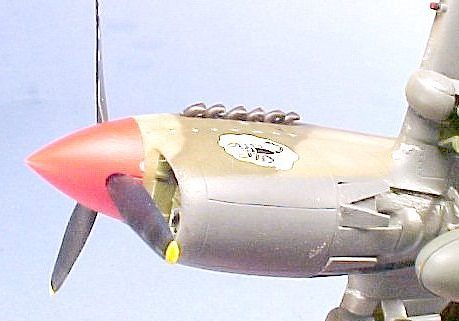 Unfortunately, AMT
tried to maximize use of the molds to too great a degree, and the nose of the
P-40F/L kits was inaccurate. When I received a pre-release kit from
Alan Griffiths at AMtech, I let him know the outline deficiencies, and suggested
that he contact Hi-Tech to see if he could purchase their resin nose to release
with the kit in order to provide a more accurate model. Alan was immediately
open to the idea, and did make a deal with Hi-Tech. As an example of his
commitment to excellence with the kits his company releases, he had Hi-Tech
re-engineer their resin nose to insure more accuracy - particularly in the lower
area of the nose that mates with the lower wing, and to insure that overall fit
with the plastic parts would be of "plug in" quality. The end result has been a
long delay in the release of the kit, but more importantly it is now a
thoroughly accurate representation of the Merlin-powered P-40. AMtech is
releasing the kit with the aftermarket nose at a price that is not much more
than what one would have expected for the regular kit. Additionally, the company
will sell the resin nose by itself at their website, for modelers who already
have the AMT kit in their stash, as well as to enable modelers to convert the
P-40E kit to an early P-40F-1 "short tail."
Unfortunately, AMT
tried to maximize use of the molds to too great a degree, and the nose of the
P-40F/L kits was inaccurate. When I received a pre-release kit from
Alan Griffiths at AMtech, I let him know the outline deficiencies, and suggested
that he contact Hi-Tech to see if he could purchase their resin nose to release
with the kit in order to provide a more accurate model. Alan was immediately
open to the idea, and did make a deal with Hi-Tech. As an example of his
commitment to excellence with the kits his company releases, he had Hi-Tech
re-engineer their resin nose to insure more accuracy - particularly in the lower
area of the nose that mates with the lower wing, and to insure that overall fit
with the plastic parts would be of "plug in" quality. The end result has been a
long delay in the release of the kit, but more importantly it is now a
thoroughly accurate representation of the Merlin-powered P-40. AMtech is
releasing the kit with the aftermarket nose at a price that is not much more
than what one would have expected for the regular kit. Additionally, the company
will sell the resin nose by itself at their website, for modelers who already
have the AMT kit in their stash, as well as to enable modelers to convert the
P-40E kit to an early P-40F-1 "short tail."
Decals will include the well-known P-40F-15"Stud" from the 325th "Checkertail Clan," a P-40L-20 "Ace of Pearls" from the 99th Fighter Squadron - the original "Tuskeegee Airmen" - and a P-40L in very different paint scheme and markings, found in a photograph of the airplane when serving in Italy. These decals are by Three Guys Decals.
|
CONSTRUCTION |
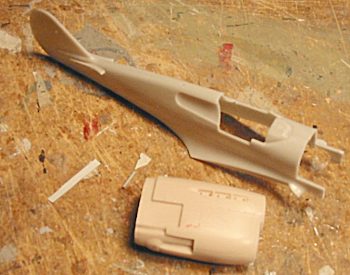 Other than the
modification to the nose, this kit assembles as did the previously-released
P-40E, and I will limit my comments to the conversion work.
Other than the
modification to the nose, this kit assembles as did the previously-released
P-40E, and I will limit my comments to the conversion work.
The backing plug of the resin nose needs to be taken off. Once this is done, it is clear where to cut off the plastic nose of the kit. The instruction sheet will provide precise drawings of where to make these cuts. Additionally, the center section of the lower wing needs to be cut open to receive the nose properly. My pre-release kit had a fit problem in the area of the nose-to-lower-wing, but this has been fixed on the production kits.
Once the nose was cut off, I assembled the fuselage halves, attached the resin nose, and applied some Mr. Surfacer to the joint.
The kit-supplied
cockpit is pretty basic, so I used the new Cutting Edge P-40F/L resin cockpit,
which is specifically designed to fit this kit. The cockpit is another
beautiful bit of work by CE's designer, Scott Battistoni, and is nearly a model
in itself. It really adds to the final look of the model is vastly superior to
the kit cockpit.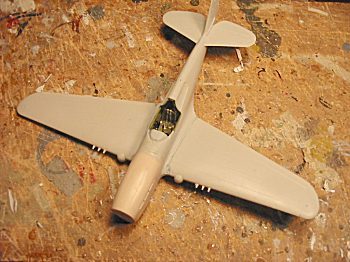
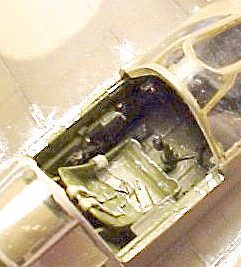 I also used the
Squadron vacuform P-40M canopy - which is exactly the same for the P-40F/L, and
fits this kit perfectly despite having been designed originally for the Mauve
P-40M kit.
I also used the
Squadron vacuform P-40M canopy - which is exactly the same for the P-40F/L, and
fits this kit perfectly despite having been designed originally for the Mauve
P-40M kit.
The only place I find any problems with fit as far as the AMtech P-40 kits are concerned is the upper wing/fuselage joint. If you try to hard to get rid of the gap there, you will end up with the wing having too much dihedral. Check your references, get the wing in proper position, then use some putty or cyanoacrylate glue (which I did) to smooth the resulting gap.
|
PAINT & DECALS |
Painting:
There is considerable
controversy over the "desert camouflage" of the P-40Fs sent to the
Mediterranean. While color photos of later P-40Ls show they were in colors very
close to the standard RAF "desert camo", the first P-40s had been painted at the
factory in Olive Drab and Neutral Grey. Some were completely over-painted with
"Tan", which became known as "desert pink" due to the shades it became when
exposed to the desert sun. Others were painted in a d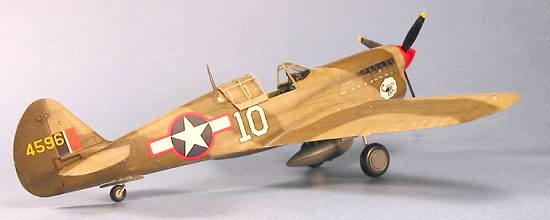 isruptive scheme that
would have been either Tan and (US) Dark Earth, or Tan and Olive Drab, all with
Neutral Grey lower surfaces. It isn't possible with black and white photos to
distinguish how faded "pink" the tan might become, or between Olive Drab or Dark
Earth as the darker of the two colors. I painted mine in faded Tan, which was a
mixture of the later USAF tan color used in Southeast Asia and Gunze-Sanyo "Sail
Color," and US Dark Earth, which I mixed using Gunze-Sanyo "RAF Dark Earth" and
"Olive Drab (2)". After these colors were applied to the model, I went back and
put mixed in some white paint in the cup, and "faded" the colors.
isruptive scheme that
would have been either Tan and (US) Dark Earth, or Tan and Olive Drab, all with
Neutral Grey lower surfaces. It isn't possible with black and white photos to
distinguish how faded "pink" the tan might become, or between Olive Drab or Dark
Earth as the darker of the two colors. I painted mine in faded Tan, which was a
mixture of the later USAF tan color used in Southeast Asia and Gunze-Sanyo "Sail
Color," and US Dark Earth, which I mixed using Gunze-Sanyo "RAF Dark Earth" and
"Olive Drab (2)". After these colors were applied to the model, I went back and
put mixed in some white paint in the cup, and "faded" the colors.
Decals:
I decided to use an old Aeromaster sheet for the P-40F Warhawk, which has "White 10" of the 57th FG. This airplane originally had the red-surround national insignia; according to the photograph of the airplane in the Squadron-Signal "P-40 In Action" book, the red surround was crudely over-painted with fresh insignia blue. The national insignia supplied on the sheet is too smooth, so I found some red-surround insignias of the correct size in the decal dungeon and did the airplane as it would have appeared a few months before it was photographed.
|
FINAL CONSTRUCTION |
I "dinged" the model with Model Master Aluminum (Non-buffing) Metalizer, and applied exhaust stains with Tamiya "Smoke." A few coats of thinned Dullcote over the Future brought the final finish to something one would have seen after a few months under the desert sun.
|
CONCLUSIONS |
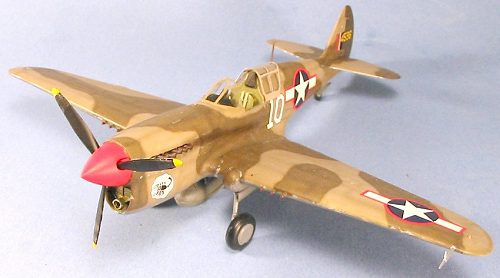 Perhaps because it has
been the P-40 that has been hardest to do, I have liked the P-40F/L sub-type the
best of all the P-40s. This new kit from AMtech, which should hit the stores
soon, allows a modeler to create a very accurate replica. It looks
great in the line-up of P-40s, and I am sure I will be modifying one of my P-40E
kits into a short-tail P-40F-1 in the near future.
Perhaps because it has
been the P-40 that has been hardest to do, I have liked the P-40F/L sub-type the
best of all the P-40s. This new kit from AMtech, which should hit the stores
soon, allows a modeler to create a very accurate replica. It looks
great in the line-up of P-40s, and I am sure I will be modifying one of my P-40E
kits into a short-tail P-40F-1 in the near future.
January 2003
Review kit courtesy of AMtech.
If you would like your product reviewed fairly and quickly by a site that has well over 175,000 visitors a month, please contact me or see other details in the Note to Contributors.
Back to the Reviews Index Page